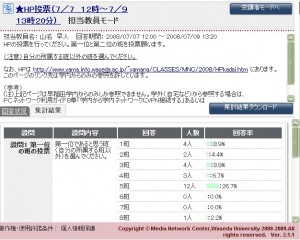03-04. Providing Feedback Shares Information with Students and Eliminates Misperceptions
Hayato Yamana
Professor, Faculty of Science and Engineering
In his field of information engineering, Professor Yamana has long used IT in both education and research. For an expert like Professor Yamana, the most beneficial aspect of Course N@vi is as a tool for feeding back to students information held by the teaching staff. He spoke about how he specifically uses Course N@vi, what improvements he’d like to see, and the system’s future potential.
Everyone at the School of Fundamental Science and Engineering uses Course N@vi to select their majors
The School of Fundamental Science and Engineering, the division of the School of Science and Engineering to which Professor Yamana belongs, has a system in which students do not choose their major and department until they are promoted to second year. Course N@vi is introduced to the students with a questionnaire on their desired major and department that is given at the conclusion of the first year.
Various guidance materials and instructions are uploaded to Course N@vi ahead of the questionnaire. This eliminates the need to leave extra copies at the administrative office for absent students, as was done in the past. And because students select the department they want to attend on Course N@vi, faculty members know immediately the number of prospective students for each department.
For departments that permit submissions, students are asked to submit on Course N@vi a report detailing why they wish to attend the department. Grading is done by a number of faculty staff members. If the grades are entered with the questionnaire function, the average of all evaluations is calculated automatically and all faculty staff members can confirm the results on the system. “Exchanging this type of information by email is not desirable from a security perspective, so it is very advantageous and convenient to complete the grading all on Course N@vi. Without Course N@vi, we would have had to build a separate system to do the same thing.”
Because all students at the School of Fundamental Science and Engineering use Course N@vi when promoted to second year, they are familiar with the system and have no problems using it in their second and subsequent years.
Feeding back information on attendance and report submissions to students
After using Course N@vi in actual courses, Professor Yamana has found that what students value most is the ability to check attendance records. His approach to attendance in large classes is to collect attendance sheets signed by students in class, enter the attendance information in an Excel spreadsheet, and then upload it all on Course N@vi. This saves the professor the trouble of entering each student’s attendance one by one directly into Course N@vi.
“In my courses, students generally cannot obtain the credit unless they attend at least two-thirds of the classes. By having the students confirm the data I have in front of me, I can avoid problems with incorrect entries.”
Professor Yamana also uses the attendance registration function to manage the status of report submissions. “Reports containing electronic circuit diagrams need to be returned on paper to the student after correcting diagrams and writing comments. Course N@vi supports entering text comments only, so it’s not convenient for exchanges of purely digital data. That’s why I still have my students submit these kinds of reports on paper.” As soon as he receives a report, he marks the report “attended” with the attendance function. Reports not received will remain “unattended” on Course N@vi, so students can verify with their own eyes whether their reports have been submitted or not.
The professor has students submit reports that do not need to be returned through Course N@vi as PDF documents. In this case, Course N@vi automatically notes that the report has been submitted and notifies the faculty staff member by email. Once a submitted report has been marked, the grade is entered on Course N@vi.
In either case, data on attendance or report submissions are shared with students in a visible form. Thus, Course N@vi plays a huge role in establishing reliable communications with students.
After the final examination, the professor uses Course N@vi’s information article function to inform students in the course about the average grade and the grade distribution. “I used to post this information on a password-protected webpage I made, but with Course N@vi I can quickly send the results just to the students in the course.”
The same information could be sent by regular email, of course, but that would involve managing students’ email addresses. “In this respect, I think the system is wonderful because we want to avoid handling personal information as much as possible.” From a security perspective as well, posting examination results on Course N@vi is much more secure than using email or the Web.
By recording everything on Course N@vi — attendance at each class, report submission statuses, and quiz and examination results — it is possible to automatically tabulate all assignments and calculate the final course grade. “You can set exactly how much weight you want to put on each specific course element. I used to manage grades in Excel but now I do everything on Course N@vi.”
Ultimately, he prints out the results sheets from the system, signs and seals them, and submits them. “It would be great if I could submit the final grades to the office with just a click in Course N@vi.”
Use of on-demand classes for courses with small enrollment
The School of Science and Engineering underwent a large-scale reorganization of its schools in 2007, resulting in a mixture of students belonging to both old schools and new schools. Consequently, there are a number of subjects with very few students, either because students belonging to an old school are retaking the subject because they failed once before or because they decided to take the subject for some reason several years into their school career. The courses must be offered as long such students exist, but to conduct all of them as in-person classes is unrealistic. To handle these situations, Professor Yamana decided to upload materials with audio commentary created in PowerPoint to Course N@vi and have students take these as on-demand classes. Student questions are taken and answered through Course N@vi.
Since 2009, university rules require that 15 classes be conducted in both First and Second Term. The professor is considering using similar on-demand classes in the future to cover classroom lectures he cannot make because of research commitments or other reasons.
Course N@vi has become more functional and easier to use: Security improvements are wanted next
Compared to other schools, more faculty members at the science and engineering schools are very adept at computers. One might think, then, that they jumped at the chance to use Course N@vi. But according to Professor Yamana, that wasn’t necessarily the case. “Precisely because they are knowledgeable about IT, many faculty members already had their own tools. So when Course N@vi appeared, they found it didn’t measure up in some areas compared to the tools they were used to. But with each upgrade to Course N@vi, it’s become much easier to use.”
One key improvement was the introduction of a formula editor so that formulas could be entered in Course N@vi. The inability to enter formulas was so restricting to discussions and other places in Course N@vi for some disciplines, that this upgrade was hailed as a breakthrough. “I think Course N@vi has now reached a point where it is particularly convenient and easy to use on its own. In my situation, at the very least, there is almost no real need to use any other system.”
One of the professor’s wants, however, is a better quiz function. With the current quiz function, it is only possible to set either open-ended answers or selection-type answers. “If we could create quizzes with numerical formulas and digits embedded into the grid, like they do on national entrance examinations, it would be a huge help and make grading much easier.” While he recognizes the necessity for quizzes because students can accumulate marks over the duration of a course, he cannot implement them at the present time in view of the time required to make up the quiz questions. “I would be grateful if the quiz function was improved to reduce the work associated with making up questions.”
He also has an idea for a future report submission function. With this function, students could scan their paper reports and the data would automatically be uploaded and submitted. This would allow students to submit their reports as easily as making a copy and they would still have the original. Faculty staff members would be able to write or draw on the uploaded reports using a tablet device and send the updated data back to the students. Since all data would be managed by a log, it would be clear when the report was submitted and when the reply was made.
In view of the current system, this function seems somewhat futuristic, but Professor Yamana says it is technically very possible.
In addition to functions for improved usability, Professor Yamana points to security management as another problem. As mentioned above, Course N@vi is a game-changer because various kinds of data and information can be exchanged without using the Web or email. Nevertheless, if someone’s ID and password are stolen, the concerns are still the same. “For example, if we provided a device that generates a one-time password, as some Internet banks do, there would be almost no risk of password theft. I would really like to see a system with this amount of security because many of the data faculty staff in particular have access to must not be leaked.”
Tips on implementing Course N@vi
“I assume you often provide materials for your lectures. Uploading these to Course N@vi can be a real timesaver. This approach deals with absentees, and you don’t have the hassle of printing and handing out materials if you ask students to download the materials before class.”
<Displaying the tabulation results from a questionnaire>
You can immediately post the tabulation results from a questionnaire given on Course N@vi.



